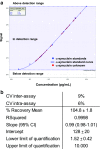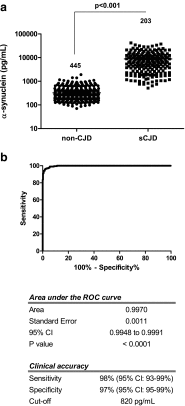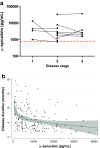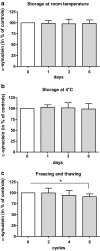Validation of α-Synuclein as a CSF Biomarker for Sporadic Creutzfeldt-Jakob Disease
- PMID: 28321768
- PMCID: PMC5840235
- DOI: 10.1007/s12035-017-0479-5
Validation of α-Synuclein as a CSF Biomarker for Sporadic Creutzfeldt-Jakob Disease
Abstract
The analysis of cerebrospinal fluid (CSF) biomarkers gains importance in the differential diagnosis of prion diseases. However, no single diagnostic tool or combination of them can unequivocally confirm prion disease diagnosis. Electrochemiluminescence (ECL)-based immunoassays have demonstrated to achieve high diagnostic accuracy in a variety of sample types due to their high sensitivity and dynamic range. Quantification of CSF α-synuclein (a-syn) by an in-house ECL-based ELISA assay has been recently reported as an excellent approach for the diagnosis of sporadic Creutzfeldt-Jakob disease (sCJD), the most prevalent form of human prion disease. In the present study, we validated a commercially available ECL-based a-syn ELISA platform as a diagnostic test for correct classification of sCJD cases. CSF a-syn was analysed in 203 sCJD cases with definite diagnosis and in 445 non-CJD cases. We investigated reproducibility and stability of CSF a-syn and made recommendations for its analysis in the sCJD diagnostic workup. A sensitivity of 98% and a specificity of 97% were achieved when using an optimal cut-off of 820 pg/mL a-syn. Moreover, we were able to show a negative correlation between a-syn levels and disease duration suggesting that CSF a-syn may be a good prognostic marker for sCJD patients. The present study validates the use of a-syn as a CSF biomarker of sCJD and establishes the clinical and pre-analytical parameters for its use in differential diagnosis in clinical routine. Additionally, the current test presents some advantages compared to other diagnostic approaches: it is fast, economic, requires minimal amount of CSF and a-syn levels are stable along disease progression.
Keywords: Biomarkers; Cerebrospinal fluid; ELISA; Electrochemiluminescence; Sporadic Creutzfeldt-Jakob; α-Synuclein.
Conflict of interest statement
The authors declare that they have no competing interests.
Figures




Similar articles
-
Sensitivity and specificity evaluation of multiple neurodegenerative proteins for Creutzfeldt-Jakob disease diagnosis using a deep-learning approach.Prion. 2019 Jan;13(1):141-150. doi: 10.1080/19336896.2019.1639482. Prion. 2019. PMID: 31306078 Free PMC article.
-
Quantification of CSF biomarkers using an electrochemiluminescence-based detection system in the differential diagnosis of AD and sCJD.J Neurol. 2015 Oct;262(10):2305-11. doi: 10.1007/s00415-015-7837-x. Epub 2015 Jul 11. J Neurol. 2015. PMID: 26162713
-
Subtype and regional regulation of prion biomarkers in sporadic Creutzfeldt-Jakob disease.Neuropathol Appl Neurobiol. 2015 Aug;41(5):631-45. doi: 10.1111/nan.12175. Epub 2015 Apr 30. Neuropathol Appl Neurobiol. 2015. PMID: 25134744
-
Cerebrospinal fluid biomarkers in Creutzfeldt-Jakob disease.Clin Neurol Neurosurg. 2005 Aug;107(5):355-60. doi: 10.1016/j.clineuro.2004.12.002. Epub 2005 Jan 12. Clin Neurol Neurosurg. 2005. PMID: 16023527 Review.
-
Clinical findings and diagnostic tests in Creutzfeldt-Jakob disease and variant Creutzfeldt-Jakob disease.Folia Neuropathol. 2004;42 Suppl B:24-38. Folia Neuropathol. 2004. PMID: 16903140 Review.
Cited by
-
Biomarkers and diagnostic guidelines for sporadic Creutzfeldt-Jakob disease.Lancet Neurol. 2021 Mar;20(3):235-246. doi: 10.1016/S1474-4422(20)30477-4. Lancet Neurol. 2021. PMID: 33609480 Free PMC article. Review.
-
Fluid Biomarkers for Synaptic Dysfunction and Loss.Biomark Insights. 2020 Aug 21;15:1177271920950319. doi: 10.1177/1177271920950319. eCollection 2020. Biomark Insights. 2020. PMID: 32913390 Free PMC article. Review.
-
TREM2 expression in the brain and biological fluids in prion diseases.Acta Neuropathol. 2021 Jun;141(6):841-859. doi: 10.1007/s00401-021-02296-1. Epub 2021 Apr 21. Acta Neuropathol. 2021. PMID: 33881612 Free PMC article.
-
Sensitivity and specificity evaluation of multiple neurodegenerative proteins for Creutzfeldt-Jakob disease diagnosis using a deep-learning approach.Prion. 2019 Jan;13(1):141-150. doi: 10.1080/19336896.2019.1639482. Prion. 2019. PMID: 31306078 Free PMC article.
-
Diagnostic accuracy of cerebrospinal fluid biomarkers in genetic prion diseases.Brain. 2022 Apr 18;145(2):700-712. doi: 10.1093/brain/awab350. Brain. 2022. PMID: 35288744 Free PMC article.
References
Publication types
MeSH terms
Substances
Supplementary concepts
Grants and funding
LinkOut - more resources
Full Text Sources
Other Literature Sources
Medical
Miscellaneous

